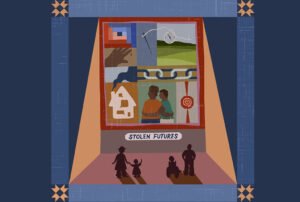
Reproductive rights restrictions are massively unpopular, but the anti-abortion movement has been successful in its coordinated efforts to limit abortion access. How, exactly, has this come to be?
The sustained backing of CPCs gives the anti-abortion movement a decisive advantage over reproductive justice and health care organizations that have not received the same level of ongoing philanthropic support.
Most coverage of this issue focuses on state legislatures and the intimidating public spectacle of anti-abortion protestors in front of local clinics. But recent research from the National Committee for Responsive Philanthropy (NCRP), an independent watchdog of philanthropy, suggests another core strategy that has gotten much less attention: the nationwide spread and influence of crisis pregnancy centers (CPCs).
CPCs are nonprofit organizations established to deter pregnant people from seeking and having an abortion. According to NCRP’s latest report, The Threat of Crisis Pregnancy Centers to the Future of Abortion Access, they are underwritten by billions of dollars and by institutions that provide them with significant organizational infrastructure. The sustained backing of CPCs gives the anti-abortion movement a decisive advantage over reproductive justice and health care organizations that have not received the same level of ongoing philanthropic support.
Crisis Pregnancy Centers: Fake Clinics to Deceive People
CPCs target potential abortion seekers with false advertising, implying that the centers provide comprehensive reproductive health care. However, they do not offer abortion services, nor do they refer patients to abortion providers. CPCs are not medical clinics, and NCRP reports that over half do not have a licensed medical professional working at their facilities. Such deception continues despite legislative attempts to require these centers to disclose information about the services they do not provide and the qualifications they do not possess.
For one example of a CPC group, NCRP points to Care Net, which was founded in the wake of the Roe v. Wade to “empower women and men considering abortion to choose life for their unborn children and find abundant life in Christ.” Over 2,000 CPCs across all 50 states are affiliated with Care Net—more than the total number of all abortion providers in the country. The organization also runs a “pregnancy decision coaching” hotline for callers who are considering an abortion.
NCRP states that these fake clinics use multiple types of misinformation to mislead pregnant people and dissuade them from seeking an abortion. Their tactics include giving people incorrect information about their pregnancy and gestational period; providing false information about abortion risks—including linking abortion to breast cancer, mental health issues, and other medical conditions—while minimizing the risks of carrying a pregnancy to term; and failing to deliver on help and services promised to persuade a birthing person to carry a pregnancy to term.
CPCs After Dobbs
The Supreme Court’s Dobbs decision, which overturned almost 40 years of precedent established by Roe, has created much confusion about the availability and legality of abortion—which is now determined by a rapidly changing patchwork of state laws. CPCs are well-positioned to exploit such confusion by spreading disinformation and misinformation that targets pregnant people in need of care. This is especially the case in states that have limited access to sexual and reproductive health services.
By using deceptive marketing and medical misinformation to direct people away from comprehensive reproductive health care and abortion, CPCs are a key part of the anti-abortion movement’s ground game.
Unsurprisingly, CPCs are also effective at misleading search algorithms: At a June Reproaction strategy session ahead of the Dobbs decision, one abortion-rights organizer noted that when she searched Google for Planned Parenthood in her area, a CPC popped up as one of the first search results.
According to NCRP, “CPCs take advantage of pregnant peoples’ urgent need to understand their gestational status and clear the hurdles created by the state as a way to get patients in the door and then use these non-diagnostic ultrasounds to explicitly persuade clients to carry the pregnancy to term.” In doing so, they gather personal information, which can be shared with other anti-abortion groups and used to harass a person who leaves the center. Such actions compromise pregnant people’s health and safety by limiting their access to quality care. While claiming they provide pregnancy care, most CPCs provide little to no medical care, and 95% offer no prenatal services.
By using deceptive marketing and medical misinformation to direct people away from comprehensive reproductive health care and abortion, CPCs are a key part of the anti-abortion movement’s ground game.
CPCs and the Anti-Abortion Movement’s Funding Advantage
As NCRP notes, following the money is important because CPCs are “embedded as beachhead ‘ground troops’ of the anti-abortion movement in almost every city and county nationwide.” Today, CPCs outnumber legitimate clinics in the US by three to one. They can be found in every state and the District of Columbia.
Now, in some states, crisis pregnancy centers have effectively replaced legitimate abortion clinics as the only option available to people with unplanned and unwanted pregnancies.
According to NCRP’s research on the tax filings of over one thousand anti-abortion groups, between 2015 and 2019, more than half of the groups’ $4 billion in revenue went to large religious and charitable nonprofit organizations—like the Knights of Columbus—that house or support CPCs.
Indeed, as NCRP’s data shows, CPC-supporting groups have a considerable funding advantage over abortion clinics and funds, which face much greater regulation: Nationally, between 2015 and 2019, five times as much foundation funding went to CPC groups ($278 million) as compared to abortion clinics and funds ($56 million).
Abortion clinics and funds are especially disadvantaged in states that have the most restrictive abortion laws. In 13 states with so-called “trigger laws” banning abortion post-Dobbs, CPCs have six times the foundation funding of abortion clinics and funds. Contrast this with the situation in states that have laws protecting abortion: The anti-abortion movement maintains a much smaller funding advantage, at 1.5 times the amount given to their abortion rights counterparts. While abortion clinics and funds in DC and the 16 states that protect abortion received $33 million, such organizations in states with restrictive laws received only $7 million.
Even worse, in at least 29 states, CPCs enjoy millions of dollars of public funding through Alternatives to Abortion programs and—most disturbingly—funds redirected from social welfare programs like Temporary Assistance for Needy Families (TANF). In a particularly cruel twist, funding for the very programs that low-income women and people of color rely on to sustain their families are being used to undermine their ability to do so. This is just one of the many ways in which limits to abortion access and full-spectrum reproductive health care harms low-income people—and especially women of color—by limiting their ability to decide when, if, and how they have and raise children.
Sign up for our free newsletters
Subscribe to NPQ's newsletters to have our top stories delivered directly to your inbox.
By signing up, you agree to our privacy policy and terms of use, and to receive messages from NPQ and our partners.
A Distinct Threat to Racial and Gender Justice
The Threat of Crisis Pregnancy Centers to the Future of Abortion Access is the last report in NCRP’s four-part series, Funding the Frontlines: A Roadmap To Supporting Health Equity Through Abortion Access, which “serves as a roadmap for funders seeking to support reproductive justice and health equity through abortion access.” Other reports in the series focus on transgender and gender-expansive patients’ needs, frontline abortion providers and funds, and the many social and economic barriers to abortion access. The roadmap is part of NCRP’s Movement Investment Project’s support for what it calls the Reproductive Access and Gendered Violence movement space.
On bringing these related movements for gender justice together under one lens, NCRP writes, “We are linking these two terms because we cannot fundamentally and systematically eliminate gender inequality and violence against women, girls, gender expansive folks, and LGBTQ+ people without lifting the barriers that exist to their sexual and reproductive health and rights [and] their mental and physical safety.”
This is especially true for women, girls, nonbinary, gender-expansive, and trans people of color. As NCRP’s roadmap notes, “Structural barriers have created a deeply unequal healthcare system that blocks access to abortion care, especially for BIPoC, poor and transgender people.”
CPCs are a threat to racial, gender, and economic justice because the majority of abortion seekers are low-income women and people of color. NCRP states that more than 60 percent of people seeking abortions identify as Black, Latinx, Asian, or Pacific Islander and 75 percent are low-income. And as advocates have pointed out, a significant percentage of these folks are already parents who are raising and supporting families.
In the US, CPCs operate in a context in which 89 percent of all counties do not have an abortion provider. In 2017, five years before Roe was overturned, six states had only one abortion provider. That same year, a medical internet research study identified 27 US cities in the Midwest, South, and Southwest as “abortion deserts” from which people would have to travel at least 100 miles to reach an abortion facility.
When funding goes to the broader institutions that support CPCs without an understanding of their ideological agenda and its consequences, philanthropy undermines reproductive freedom and health justice—especially for women, gender-expansive, and transgender people of color.
But as NCRP points out, geographic proximity to a clinic doesn’t guarantee access to care. Few clinics have services designed specifically for transgender patients. For uninsured and underinsured low-income people, an unexpected pregnancy means choosing between next month’s rent or an abortion, which costs on average $750, depending on the location and type of procedure needed.
What Philanthropy Must Do
Funders should effectively steward their considerable resources. When funding goes to the broader institutions that support CPCs without an understanding of their ideological agenda and its consequences, philanthropy undermines reproductive justice—especially for women, gender-expansive, and transgender people of color. NCRP states, “There are dozens of legitimate health facilities and non-profits that would be better recipients of direct resources and support.” As discussed at NPQ, this means funding grassroots, women-of-color-led reproductive and birth justice organizations that advocate for and provide safe, equitable care. NCRP mentions a few such organizations: Sister Reach, CHOICES Memphis Center for Reproductive Health, National Birth Equity Collaborative, SisterSong’s Birth Justice Care Fund, and Indigenous Women’s Rising.
The report also highlights how organizations like Reproaction raise critical awareness about the threats posed by CPCs through its Anti-Abortion Fake Clinic Database. Similarly, a campaign by Abortion Access Front (formerly known as Lady Parts Justice League), a reproductive rights nonprofit that uses humor and outrage to fight anti-abortion forces, sets out to #ExposeFakeClinics.
NCRP makes the following recommendations about what philanthropy must do to support reproductive justice and abortion access:
- Prioritize state and local abortion funds in your grantmaking
- Distribute unrestricted funding to legitimate abortion clinics
- Screen current and future grantees for deceptive groups
- Fund comprehensive sex education, including perinatal education and abortion care
- Invest in policy work that combats the opposition directly
Investing in Abortion Storytellers
Funders can also invest in cultural work. The report highlights and uses an important strategy in the fight for abortion access: storytelling to destigmatize abortion. NCRP’s roadmap includes a collection of stories that make clear the impact of abortion stigma and limits to access. The report on CPCs includes a story from WeTestify, a nonprofit organization dedicated to the leadership and representation of people who have abortions. Along with peer organizations like Shout Your Abortion and Advocates for Youth’s Abortion Out Loud, WeTestify does this by investing in abortion storytellers to elevate their voices and lived expertise, particularly those who are of color, from rural communities, queer-identified, with varying abilities and citizenship statuses, and who needed support while navigating barriers to abortion care. We Testify storytellers receive storytelling, media, and anti-harassment training. They are also encouraged “to not only share their abortion experiences but the systemic issues that set in play the various barriers or privileges that affected their experience.”
One such storyteller, Maleeha Aziz, describes her harrowing personal experience with a crisis pregnancy center. A low-income immigrant, Aziz did not want to be pregnant—but she didn’t realize how many hoops she would have to jump through to get an abortion in the US. Looking for help, she turned to a sympathetic cousin who was in medical school. Her cousin searched Google for places that provide free or low-cost services and texted her a list. As Aziz later found out, many were CPCs. She eventually managed to get a medication abortion—but only after much confusion and travel to another state.
Telling Anti-Racist Stories to Advance Reproductive Justice
Abortion storytelling is central to reproductive justice. As WeTestify founder and Executive Director Renee Bracey Sherman notes in a 2021 article for Responsive Philanthropy, “We cannot undo the harm of white supremacy without confronting the real experiences of the people it impacts.” This means combatting racialized and gendered narratives and tropes that undermine the personhood and bodily autonomy of women and people of color.
The anti-abortion movement uses racist, sexist, and xenophobic stereotypes to undermine abortion rights at the state and national levels. For instance, “They talk of ‘taxpayer funding of abortions’ to conjure the anti-Black ‘welfare queen’ trope in hopes that the audience will forget that Medicaid insurance recipients also pay taxes and that no matter what, everyone deserves unfettered access to medical care,” writes Sherman. They deploy such tropes even as racial inequities in US health care have created a Black maternal and infant mortality crisis. Ignoring these inequities and other forms of state-sanctioned violence against Black women and girls, fake clinics like CPCs use false advertising and medical misinformation to pressure women of color to carry unwanted pregnancies to term—potentially endangering their lives.
It’s in this context that CPCs and their massive funding advantage are especially dangerous. NCRP’s research reveals only a fraction of the support received by CPCs, as it doesn’t include support from individual donors or donor-advised funds. Nevertheless, their findings indicate that, as Stephanie Peng, NCRP’s Movements Research Manager, puts it, “…navigating a post-Roe world requires investing significant, long-term resources in the local abortion clinics and funds fighting in the trenches.”
Why? Because without sustained, ground-level investment to develop progressive infrastructure in the politically conservative states that have banned or severely restricted abortion, more people—especially women of color—will suffer.











